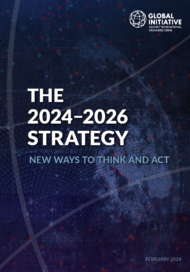Event Details
Posted on 11 Sep 2017
Dr Mark Shaw, the Director of the Global Initiative against Transnational Organized Crime presented a key address at INTERPOL’s 45th European Regional Conference, convened in St Johann im Pongau (Austria) on 16-18 May 2017.
Keynote Address of Dr. Mark Shaw, Director, Global Initiative against Transnational Organised Crime
Shifts in the global illicit economy and the future impact on Europe
Many thanks for the invitation to present to you today. And it is a real privilege to be part of Interpol’s European meeting.
As we meet here, I think it is clear that organised crime has evolved rapidly in the recent past. Indeed, there is of course good evidence to show that the phenomenon has changed in an important series of stages since the 1950s. Many of you in this room may recall previous debates particularly in the early 1990s when a series of events came together that arguably accelerated organised crime as the process of globalisation began to gain pace.
These trends have continued to evolve. I believe now, however, that we have entered a period of crucial significance: A complex interaction between political crises and conflict, in a context of an acceleration of technological changes as well as a deepening of globalisation. In terms of organised crime, we are not dealing with a situation where things are secure and predictable any longer.
As a reflection of the degree to which the phenomena itself have risen higher up on the public policy agenda over the last number of years, it is now almost unprecedented that organised crime appears in policy discussions where it was never mentioned before. To take only one example: the 2030 Sustainable Development Agenda of the United Nations makes clear reference to organised crime, with one in ten targets covering areas where organised crime will have a decisive impact on success or failure.
These developments are reflected too in the activities and reach of the Global Initiative against Transnational Organized Crime itself – which has expanded rapidly since our formation in 2013. Indeed, one of our key priorities is to bridge the divide between law enforcement partners and the growing number of other people and institutions engaged directly or indirectly in the fight against organised crime.
In all of the multiple interactions and the on-going research in which we have been involved the same conclusion emerges like a drum beat: no country or community of practitioners or experts can confront the challenge of organised crime alone.
To make the point clearer for us here today: events outside of the wider European area will increasingly shape the nature and activities of criminal networks within the continent. Day to day policing will be connected to events happening far away – and the nature of the problem will become increasingly complex.
To illustrate this, I want to highlight three big trends that I feel are and will continue to shape the future of organised crime and the debate around it – in Europe of course but also further afield. They also say much about how we must face these threats – an issue I will return to by way of conclusion.
The three trends are as follows: first, an evolution in global illicit trafficking markets and their impacts; second, criminal networks that attack and undermine the infrastructure of governance, trade and the commercial sector; third, the intersection between organised crime, conflict, corruption and state weakness in several key zones.
Let me consider each of these themes briefly in turn.
First, the evolution of illicit trafficking.
Illicit trafficking markets are now shifting in important ways – in some markets the result of greater availability of illegal commodities and in others growing scarcity.
Illicit narcotics remain the largest illicit market – and one in which criminal formations of a variety of types are deeply embedded. This will continue. But drug markets will be disrupted in future by two factors.
First, increases in supply of some drugs with cheaper street prices and reductions in quality – this is now the story in many cities all over the developing world. This has also been associated in many places with increases in violence. And this is and will continue to be combined with the much wider use and smuggling of prescription pharmaceuticals.
Second, a greater diversity in the ways in which drugs will be regulated. While it is unclear how this will develop, it is highly likely in at least the next decade that we will see the deregulation or decriminalisation of a wider set of drugs – not internationally but in individual countries. We do not really know what the consequences will be for organised crime. Developments in the cannabis market in particular are worth watching to gain some insights here.
I want to emphasise however that the assumption made in the debates on decriminalisation or legalisation that these will miraculously solve organised crime is almost certainly misplaced. I am not so much commenting on the legalisation discussion per se, rather pointing out that it has and will have an impact on organised crime.
In my view, the future is likely to be messy: some supply chains will be half legal and half illegal, black markets (as indeed today in the case of cigarettes) will develop if taxes, say on marijuana, are too high, and well-resourced drug cartels may still seek to influence markets with violence, including targeting any emerging commercial operators.
Such disruption in drug markets are almost certainly likely to favour highly mobile, dynamic and widely networked global criminal formations, rather than highly structured cartels. West African organised crime with their global network and reach will be particularly well placed here.
But in the future, drugs – while dominant – will be only one of several illicit markets. While the drugs market will be driven by the need to expand markets based on twofold forces of increases in supply on the one hand and a growing diversity of products that must be sold on the other hand, other markets will be driven by growing scarcity.
The most prominent of these will be the market for environmental products and resources.
The list of products that are now part of this criminal economy is widely known: rhino horn, elephant ivory, hardwoods, etc.
But these are merely the tip of the iceberg: the multitude of species and products will expand. Criminal networks active in these markets recognise that scarcity always means that new products must be found.
The recently published results from a UNODC database of 164,000 individual cases of wildlife crime illustrates this point well – they concerned trafficking in 7,000 individual species. These stretch from German collectors of cycads or small tortoises in Southern Africa for example to new markets being created for lion bones.
New markets will be created where old ones are extinguished – and in this case of course I mean that quite literally. Already, European citizens in a multitude of places around the world are involved in such markets as collectors, buyers or organisers. Demand is being driven in particular by the advertising properties of social media.
Few European countries have much specialism in the smaller details of the environmental trade – but the devil will increasingly be in the detail.
I have mentioned drugs and environmental markets. There is a third market that, at least as far as organised crime is concerned, is now a major point of expansion. It will come as no surprise to you that this is the market for moving people.
It is here that the most visible implications of wider instability will be felt in the European context. In many ways, we may only be at the beginning of the real criminal formation in this sector. The more efforts are made to stem trafficking the more the hidden power of organised criminal and smuggling networks will strengthen.
It would be fair to say that combinations of political crises and individual aspiration (as seen and communicated through social media) will keep people moving and wanting to do so in the future. But the barriers will be higher than ever before. And there are significant numbers of actors and expertise to help aspiring migrants to subvert these barriers.
Markets for migration however – indeed as they already have – will cross-over with markets for violence: namely the extortion and enslavement of people on the move and the sourcing of human organs from vulnerable people. We can see that this is already occurring.
There is not the time to examine each of these three markets in more detail today. But what is particularly important from our perspectives is how rapidly these markets have changed – not only in reality on the ground, but also from a political and policy perspective: in each case these are often emotional and very public debates.
They also each connect in different ways with patterns of instability and terrorism – highlighting the degree to which illicit resources flows like drugs, environmental products and people are and will remain important resource streams for insurgency, violence and terror.
Let us now turn to my second theme: the vulnerability of government infrastructure and the sinews of commerce and trade to criminal activity.
Only in the last few days have we seen an almost classic case of this: the hacking of data from vulnerable computer systems across the world, and its use for one of the oldest crimes, that of extortion.
In a sense, extortion is the quintessential crime of mafia organisations. The difference here is that the violence associated with the crime will be a less direct violence against people who refuse to pay – but the indirect destruction of data and systems that provide services to people and which allow the smooth operation of government, commerce and trade. It has important implications for transport and communication infrastructure, power supply and political systems themselves.
Almost remarkably, as the recent case made the news, the Global Initiative against Transnational Organized Crime has been completing a major research study on the impact of organised crime across the commercial sector.
The results are in some ways astonishing. Major and minor companies report that they are being targeted by ransomware – some pay, others do not and many do not even report the crime. The growth has been particular strong in the developing world. It is strengthening criminal expertise and networks to home in on wealthier targets in the developed world – including of course in Europe.
But our work suggests that the impact of organised crime targeted or the commercial sector is considerable – much more than we had ever assumed.
The counterfeits goods industry has risen in the course of less than a decade from an area of activity worth some $250 billion to an estimated $461 billion. It has also diversified: the food industry is a particular target but there is almost no commercial sector that is not affected.
Our study also shows a massive spike in asset theft in the transport and logistics sector for example in 2015 and 2016. While we still need to understand the implications, it is clear that important changes are underway and that as a community we are not well prepared.
Nevertheless, the position of organised crime and the private sector is particularly complex: the main reason for this is that organised crime both use the legitimate channels of private commerce (think of the container trade or the internet) as well as targeting companies for criminal profits.
The result is that the incentives for private sector companies to act against the growing threat of organised crime are often mixed. Criminals pay for some services and products while also exploiting them. Private sector actors have also not always been innocent players in the criminal economy. The wider infrastructure of tax evasion for example has been crucial for hiding the laundered profits of criminal organisations, too.
There is an added complexity. The private sector has huge resources of its own and in many cases these are highly concentrated, with commercial power held in the hands of only a few companies. That in itself may reduce the incentive for outside cooperation and reinforce arguments for going it alone.
This results in only few examples of private-public sector partnerships to curb the phenomenon, as recent research conducted by the Global Initiative against Transnational Organized Crime shows.
Companies are much more likely to look internally for solutions. Law enforcement is often distrusted – and that is not confined to the developing world alone. The regulatory burden that companies feel they bear in some areas – particularly in the financial sector – is felt to be disproportionate to the results it achieves.
These sentiments are of crucial consequence for law enforcement in all countries. They are disrupting our ability to respond.
My third and final theme is the intersection between organised crime, conflict, corruption and state weakness in several key zones.
Weak, corrupt or conflict-torn states are now without doubt significant vectors in the evolving global political economy of organised crime. The increasing intersection between the issue of organised crime and the peace and security discussion is now much more common than in the past – and Interpol of course has a crucial role to play.
This reality is starkly illustrated by counting references to organised crime or illicit trafficking in Security Council Resolutions concerned as they are with peace and security – there has been a consistent up-tick in this phenomenon since 2000.
It is in these conflict zones and areas of state weakness, where much of the discussion on global organised crime and its intersection with global security challenges will continue to shift. Sustaining and fuelling conflict will require linkages to criminal networks and markets – there will in short be a blurring between the ideological and the criminal.
In that context, the lines between criminality and terrorism will continue to shade into each other. The “taxing” of illicit trade in the context of state weakness to sustain conflicts and terrorist campaigns is occurring when the debate on the links between organised crime and terrorism is not always well understood.
Importantly too, criminalised state actors will become important vectors in the global criminal economy. Corruption within law enforcement remains one of the biggest stumbling blocks to an effective response in in many places – but with increasing global consequences.
So, in short, perhaps the most significant policy developments in the current global environment are coming in the area of organised crime and peace and security.
A swathe of states now fit this description: Africa is highly vulnerable. An arc of often inter-connected conflict zones extends from the Sahel, through northern Nigeria, the Central African Republic, to Sudan, Eastern Congo, and the Horn of Africa. Within Europe itself remain the vulnerabilities in the Balkan region but also elsewhere.
Perhaps the clearest and most pertinent example of conflict and instability on the borders of Europe is that of Libya. A combination of its geographical position, chronic instability and on-going conflict, has empowered critical networks of traffickers, whose connections stretch deep into the Sahel and across to West Africa. More dangerously, illicit trafficking has become part of the conflict itself – empowering and resourcing conflict protagonists.
Different forms of instability in several states on the periphery of the European region may have particularly critical implications for the evolution of organised crime. The two most important examples are Nigeria and Turkey, but there are others. Political and economic stability in these countries is, thus, of huge importance not only from a political perspective but also from a law enforcement one.
The combination of these three themes that I have highlighted will be crucial shapers of future patterns of organised crime that impact upon Europe.
In conclusion, what can be done?
Apart from strengthening the capacities of national law enforcement, I think there are three important strategic conclusions to draw:
Firstly and most obviously, to strengthen the communication between law enforcement entities. This of course is the raison d’etre of Interpol. But it also requires new ways of thinking about the world and about organised crime that few law enforcement agencies engage as much with as they should. It means effectively looking at the issue of organised crime as a strategic threat, examining it through a political economy lens rather than through a tactical law enforcement one. It also means re-thinking and strengthening multilateral and cross-border responses in a political context in which this has undoubtedly become more challenging.
Secondly, the absolute necessity of forging more effective strategic partnerships with the private sector, despite all of the difficulties of doing so. I am very aware of the dangers that present themselves here: the sense that private money and interests may subvert law enforcement objectives. These are real concerns. But at the same time, almost all law enforcement agencies are short on critical skill sets to confront a new generation of crime. And the private sector hold enormous control over the levers and information collection points in a globalised world. We need to get better at such cooperation or we will fail. And one marker of that failure will be private corporations that effectively police themselves and their markets without state inputs. That will not benefit the public interest and it will weaken state capacities in the long term.
Thirdly and finally, instability in and on the borders of the European region requires a forward thinking and strategic response. In states with the capacity to do so it requires reaching outside of their borders in complex alignments of development, security and policing responses, not only stabilising conflict zones but thinking more carefully how the levers of illicit markets can be altered. Law enforcement expertise is only one component of an array of government responses and senior law enforcement officials must ensure that they are able to engage at the highest level of government to make the point that a coordinated and strategic response is required.
As I have tried to outline, organised crime and associated patterns of global trafficking have evolved in a series of rapid steps. In describing this, I have used the term “complexity” on several occasions. It is without doubt a volatile cocktail – not one that is easily understood as it cross-cuts so many areas of policy and practice with so many regional variations and is itself occurring in, connected to, and influencing a changing geo-political landscape. But it will remain one of the great challenges of our age of fractured globalisation – and one that we who are here now are burdened with defining an adequate response.
I thank you.



